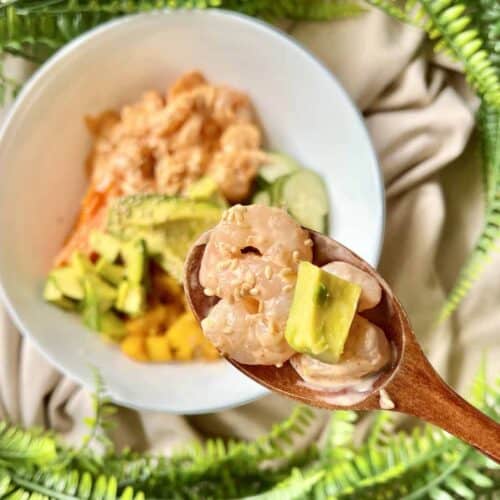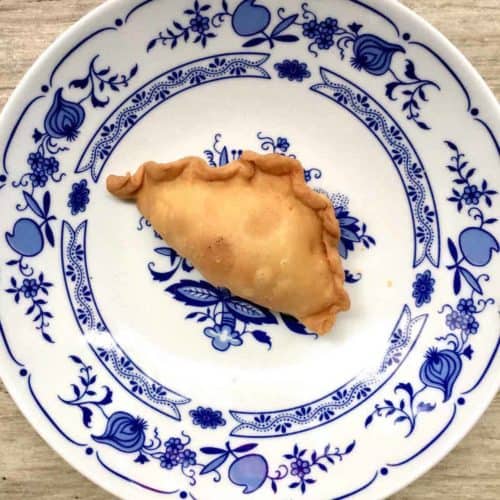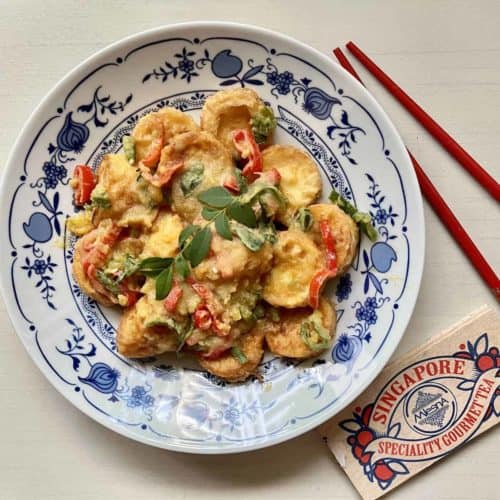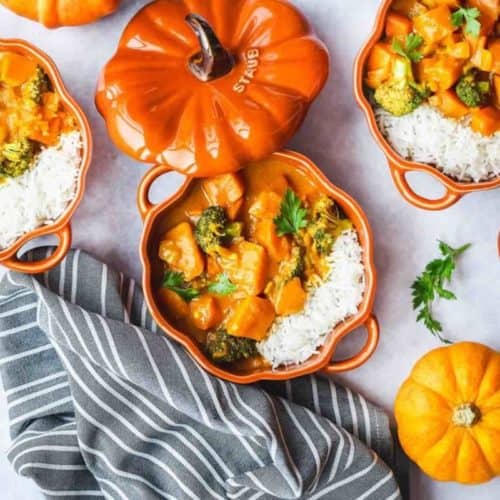The most common Asian Herbs to take your cooking to a new level! Details on how to use everything from common mint to torch ginger flower!

Jump to:
1 thing the various Asian cuisines have in common is the liberal usage of fragrant herbs in their dishes.
Different Asian cuisines use different herbs. Vietnamese cooking, for example, is well-known for its liberal usage of fresh herbs such as Vietnamese Mint (Rau Ram), Lemongrass, Common Mint and Thai Basil. Indian cuisine, on the other hand, uses more of curry leaf and coriander.
To find out more about how to use each culinary herb, scroll down!
I had SO MUCH problems growing my own herbs, till I got an indoor gardening kit with a LED light. (Click through if you want reviews of the best indoor herb garden kits!)
Note: for Asian spices such as sesame seeds, black pepper and star anise, please click here. (Had to separate the 2 posts or it would be too long!)
Bay Leaves

- What It is: An aromatic leaf from the laurel tree that is often sold in its dry form.
- Taste: The flavor is so subtle Seriouseats devoted a whole article to the taste. It's usually used to deepen the flavors of the other ingredients.
- Where to buy: Also a common ingredient in Italian cooking so you won't have a problem finding dried bay leaves in a mainstream grocery store.
- How to Use: Usually in noodle soup (e.g. Vietnamese pho) or braised meats and stews.
Expert Tip: in the Asian supermarket, there is also Indian Bay Leaf that is sometimes simply labelled as Bay Leaf. However, the 2 are not the same! The "regular" bay leaf has pinnate veins (originating from and spaced along a central vein) whilst Indian bay leaf has parallel veins (veins that meet in the top and bottom of the leaf.)
Chinese Chives
- What It Is: also known as garlic chives, looks like a thicker version of regular chives and a smaller version of spring onions
- Taste: like a mix between onion and garlic
- Where to Buy: you can get the seeds from Walmart but fresh chives need to be bought from the Asian supermarket
- How to Use: for Chinese cuisine, in stir-fries and dumplings
Coriander Leaves
- What It Is: also known as cilantro or Chinese parsley. The shape is a little similar to flat-leaf parsley. The entire plant from root to leaves is edible, with coriander root an important ingredient in Thai cuisine. (To learn about coriander seeds and other Asian spices, click here.)
- Taste: fresh but this is a polarising herb- some people feel it tastes like soap!
- Where to Buy: fresh cilantro can be bought at grocery stores such as Walmart and Whole Foods.
- How to Use: as a garnish after cooking to preserve the flavor
Curry Leaves
- What It Is: a herb common in Sri Lanka, Singaporean, Malaysian and Indian cooking with dark green sharp leaves. (Not the same as curry powder!) Other names are: Murraya koenigii (scientific name), sweet neem leaves, Daun Kari(Malay), Curry Bush, Karapincha, Karwa Pale, Garupillai, Kerupulai, 咖哩叶, 调料九里香, 麻绞叶 and kariveppilai (Tamil)
- Taste: earthy, almost bitter, can be nutty and citrus-like
- Where to Buy: can be hard to find fresh curry leaves outside of Asia (some countries have restrictions) but it's quite easy to grow in the right climate. Having your own pot is a great way to make sure you always have some on-hand.
- How to Use: comes in its fresh and dried forms as well as a powder. Used in dal, chutney as well as many curries and salted egg recipes.
Garlic
- What It Is: common to almost all cuisines, not just Asian!
- Taste: varies widely can be pungent or soft, depending on how the garlic is handled and cooked.
- Where to Buy: any supermarket
- How to Use: the skin is usually removed but not always (e.g. Bak Kut Teh.) Roasting or simmering the whole clove makes the flavor softer and sweeter. Has a lot of health benefits and great for the immune system! It is also used in a lot of Chinese sauces such as Char Siu Sauce and Black Bean Sauce.
Ginseng
- What It Is: a traditional Chinese ingredient used for centuries for medicinal purposes (but also in culinary dishes.) Also found in Korean cuisine. It is sold fresh or dried for later use.
- Taste: herbal. Using too much can make it bitter.
- Where to Buy: Chinese or Korean supermarket but can be pricey.
- How to Use: this medicinal herb can be used in its fresh or dried form. It gives you a lot of energy so taking too much too close to dinner can give you insomnia! In fact, Chinese people traditionally believed that sucking on some ginseng during childbirth gave the expectant mother the strength to give birth.
Holy Basil
- What It Is: known as Tulsi or Hot Basil, it's associated with Thai food but native to India
- Taste: spicy
- Where to Buy: Asian or Thai market
- How to Use: the leaves, seeds and stem are edible but the leaves are more commonly used for cooking
Lemongrass

- What It Is: also known as citronella, this is a perennial grass or long herb with a light green exterior and white interior. It grows in clumps. The base- which is what we usually use-is stiff and hard whilst the top consists of thinner leaves.
- Taste: bright and citrusy
- Where to Buy: You can find it in the produce section of supermarkets such as Whole Foods.
- How to Use: to get the most flavor, bang the lemongrass with the back of a pan or rolling pin. The thick and hard outer leaves are usually discarded, whilst the softer interior is used. It's a key ingredient in many Southeast Asian recipes, such as Thai curries, soups, and salads. You can also use it in simple syrups and ginger tea.
Used in These Recipes
Kaffir Lime Leaves
- What It Is: a plant with a shiny, dark green double leaf. It also grows kaffir lime fruits, but the fruit is not as widely used as the leaves because the juice is just too sour!
- Taste: a fragrant cross between mandarin orange, lime and lemon
- Where to Buy: Asian supermarkets
- How to Use: too tough to be eaten so the leaves are usually crushed then added to soups and stews. Alternatively, tender young leaves are julienned into very long thin slices for salads. Very common in Thai cooking to balance the heat.
(Common) Mint
- What It Is: also known as Moroccan spearmint, applemint or sage of Bethlehem, there are several varieties such as spearmint and peppermint.
- Taste: tastes like mint!
- Where to Buy: readily available at mainstream grocery stores
- How to Use: mint leaves are often used in Thai and Vietnamese recipes, such as pho and Vietnamese Sizzling Crepes.
Pandan

- What It Is: also known as screwpine, its a tropical plant with long dark green leaves. Grows prolifically in warm climates.
- Taste: it has a grassy, warm flavor somewhat reminiscent of vanilla. (Which is why it's called vanilla of the East!)
- Where to Buy: you can find fresh pandan leaves or pandan extract in the Asian markets.
- How to Use: widely used in Southeast Asian cooking, such as Singaporean and Malaysian food, to impart color and fragrance. It can be used in its whole leaf form (crushed then tied into a knot) or the leaves are blended with water to make pandan extract which is then added to dishes. Goes very well with coconut milk. 1 of the most famous recipes which uses pandan is Singapore Hainanese Chicken Rice.
Used in these Recipes
Shallot
- What It Is: like a tiny red onion but much sweeter. More commonly used in Asian cuisine than onions.
- Taste: like sweet onions
- Where to Buy: for fresh shallots, go to Asian markets. Fried shallots can be found on Amazon.
- How to Use: fresh onions are added to stir-fries and, rempah (Southeast Asia) and curries or sliced and deep fried as a garnish
Shiso
- What It Is: Red or green leaf herb used in Japanese cuisine, Korean cooking and Vietnamese food
- Taste: citrus meets, mint, basil, coriander and anise. Can be an acquired taste.
- Where to Buy: fresh leaves are available at the Korean or Japanese market and powdered shiso online
- How to Use: you've seen the green leaves in sushi and sashimi platters as well as fried in tempura. You can roll it in Korean gimbap or Vietnamese wraps. Can also be added to stir-fries or salad.
Spring Onions

- What It Is: also called scallions and green onions, this is 1 of the Holy Trinity of Chinese stir-frying (the other 2 ingredients being garlic and ginger.) It's also very commonly used in Korean food.
- Taste: fresh and slightly sweet. It's so flavorful, it's the star of dishes such as Cong You Bing.
- Where to Buy: you can get them fresh from Walmart or Asian markets
- How to Use: the flavor is stronger in the leaves, so we use the leaves more than the bulb. The long leaves are lighter at the bottom and dark green at top. In Chinese cooking, the white part and dark green part are used for different things.
Thai Basil
- What It Is: not to be confused with Holy Basil- although sometimes used as a substitute when cooking Pad Kee Mao- this herb has green-purple leaves
- Taste: with notes of anise and licorice
- Where to Buy
- How to Use: sturdier than Italian basil, these survive cooking better. Can be used in stir-fried noodles, curries and more.
Torch Ginger Flower
- What It Is: this flowering plant is also known as Bunga Kantan and used in Malay and Peranakan food. It's a beautiful pink flower that is as gorgeous as it is delicious
- Taste: sweet, sour, citrusy
- Where to Buy: select Asian supermarkets but they're pretty rare in North America.
- How to Use: thinly sliced and used in salads such as Rojak. Also found in curries and Assam laksa.
Vietnamese Mint
- What It Is: 1 of my favorite herbs, this plant has dark green and sometimes even purple leaves.
- Taste: fresh and almost lemony?
- Where to Buy: you'll need to trek to the Asian market for the 1st fresh bunch. After that, it is easy to propogate if you have copious amounts of water and sunlight. It's also sold dried but the flavor goes fast.
- How to Use: Singapore Laksa and Vietnamese recipes
If you have something to add to this list of Asian popular herbs, let me know in the comments below!













































Comments
No Comments